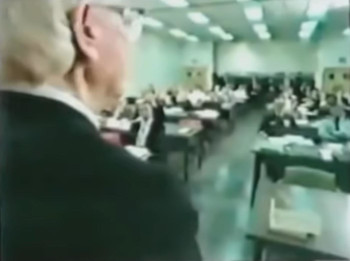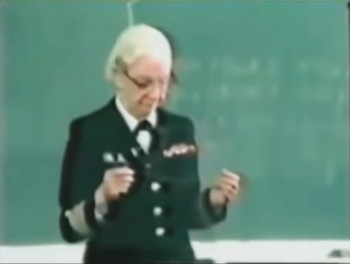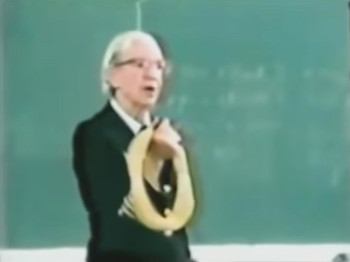Admiral Grace Hopper Explains the Nanosecond


"They started talking about circuits that acted in nanoseconds. Billionths of a second. Well, I didn’t know what a billion was (I don’t think most of those men downtown knew what a billion is either). And if you don’t know what a billion is, how on Earth do you know what a billionth is?
"I fussed and fumed. Finally one morning, in total desperation, I called over to the engineering building and I said, 'Please cut off a nanosecond and send it over to me.' And I brought you some today."

"Now, what I wanted when I asked for a nanosecond was: I wanted a piece of wire which would represent the maximum distance that electricity could travel in a billionth of a second. Now, of course, it wouldn’t really be through wire. It’d be out in space, the velocity of light. So, if you start with the velocity of light and use your friendly computer, you’ll discover that a nanosecond is 11.8 inches long (the maximum limiting distance that electricity can travel in a billionth of a second).
"Finally, at the end of about a week, I called back and said, 'I need something to compare this to. Could I please have a microsecond?'
"I’ve only got one microsecond (so I can’t give you each one). Here’s a microsecond: 984 feet."

"I sometimes think we ought to hang one over every programmer’s desk (or around their neck) so they know what they’re throwing away when they throw away microseconds.
"Now I hope you all get the nanoseconds. They’re absolutely marvelous for explaining to wives and husbands and children and Admirals and Generals and people like that."

"An Admiral wanted to know why it took so damn long to send a message via satellite. And I had to point out that between here and the satellite there were a very large number of nanoseconds. You see — you can explain these things. It’s really very helpful, so be sure to get your nanoseconds."
Admiral Grace Hopper (wikipedia.org) amongst many other marvelous things…
"…became known for her 'nanoseconds' visual aid. People (such as generals and admirals) used to ask her why satellite communication took so long. She started handing out pieces of wire that were just under one foot long - 11.8 inches (30 cm) - the distance that light travels in one nanosecond. She gave these pieces of wire the metonym 'nanoseconds.' She was careful to tell her audience that the length of her nanoseconds was actually the maximum distance the signals would travel in a vacuum, and that signals would travel more slowly through the actual wires that were her teaching aids. Later she used the same pieces of wire to illustrate why computers had to be small to be fast. At many of her talks and visits, she handed out 'nanoseconds' to everyone in the audience, contrasting them with a coil of wire 984 feet (300 meters) long, representing a microsecond. Later, while giving these lectures while working for DEC, she passed out packets of pepper, calling the individual grains of ground pepper picoseconds."
(Note: You can currently find the original video source for the above still images and transcript under the title "Admiral Grace Hopper Explains the Nanosecond" on YouTube, but I’m trying to limit linking to there from here. I could not find the video on archive.org.)
Back to computing